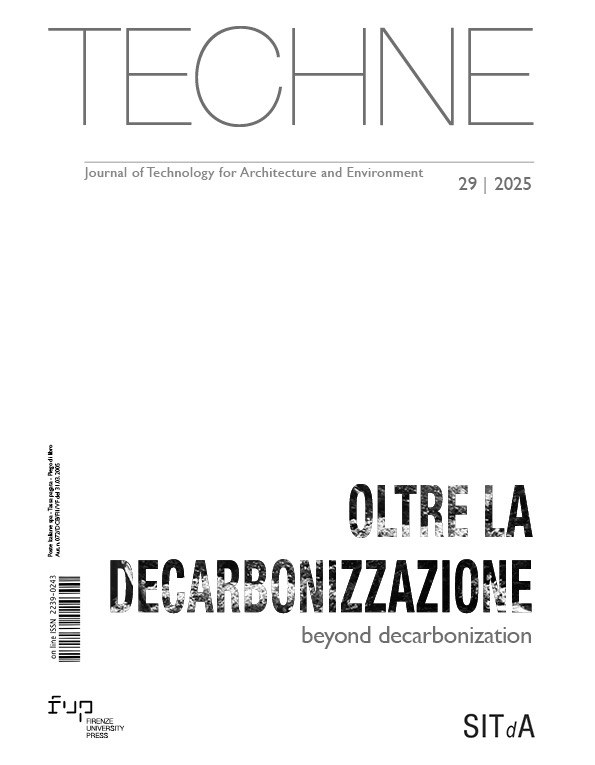Published 2025-07-31
Keywords
- Urban design,
- Carbon neutral,
- Co-creation processes,
- Positive Energy Districts
How to Cite
Copyright (c) 2025 Alessandra Battisti, Antonella Violano

This work is licensed under a Creative Commons Attribution 4.0 International License.
Abstract
The urgency of combatting climate change requires revising urban regeneration and planning models oriented towards climate neutrality. This means not only reducing operational emissions, but also using integrated adaptation and mitigation strategies to manage embodied carbon. Approaches like “transformative resilience” and “nature-based thinking” foster cohesive governance, while the Positive Energy District (PED) model promotes energy self-sufficient neighbourhoods. Co-creation with local communities and the use of advanced digital tools allow the climate transition to be optimised, also with the support of new European regulations incentivising zero emission technologies. The adoption of green infrastructures and sustainable urban planning improve quality of life, underscoring the role of resilient design as a strategic lever for decarbonisation and urban sustainability.
Downloads
References
- Bataleblu, A.A., Rauch, E. and Cochran, D.S. (2024), “Resilient Sustainability Assessment Framework from a Transdisciplinary System-of-Systems Perspective”, Sustainability, Vol. 16, p. 9400. Available at: https://doi.org/10.3390/su16219400. DOI: https://doi.org/10.3390/su16219400
- COM(2023)161 Proposal for a regulation of the European Parliament and of the Council on establishing a framework of measures for strengthening Europe’s net-zero technology products manufacturing ecosystem (Net Zero Industry Act).
- Christidis P., Ulpiani G., Stepniak M. and Vetters N. (2024), “Research and innovation paving the way for climate neutrality in urban transport: Analysis of 362 cities on their journey to zero emissions”, Transport Policy, Vol. 148/2024, pp. 107-123. Available at: https://doi.org/10.1016/j.tranpol.2024.01.008. DOI: https://doi.org/10.1016/j.tranpol.2024.01.008
- European Commission (2024), Decision 2371 of 17 April 2024, Horizon Europe Work Programme 2023-2025 12. Missions and Cross-cutting Activities.
- European Environment Agency (2024), European Climate Risk Assessment. EEA Report 01/2024. Available at: https://www.eea.europa.eu/en/analysis/publications/european-climate-risk-assessment (Accessed on 09/01/2025).
- Futerra and World Business Council for Sustainable Development – WCBSD (2019), The good life goals. For world-changing businesses. A guide to making the Sustainable Development Goals relevant to your employees and customers. Available at: https://docs.wbcsd.org/2019/09/WBCSD_Good_Life_Goals-Business_Guide%202019.pdf (Accessed on 09/01/2025).
- Habib, S., Tahir, F., Hussain, F., Macauley, N. and Al-Ghamdi, S.G. (2023), “Current and emerging technologies for carbon accounting in urban landscapes: Advantages and limitations”, Ecological Indicators, Vol. 154, p. 110603. Available at: https://doi.org/10.1016/j.ecolind.2023.110603. DOI: https://doi.org/10.1016/j.ecolind.2023.110603
- Huo, D., Huang, X., Dou, X. et al. (2022), “Carbon Monitor Cities near-real-time daily estimates of CO2 emissions from 1500 cities worldwide”, Sci Data, Vol. 9, p. 533. Available at: https://doi.org/10.1038/s41597-022-01657-z. DOI: https://doi.org/10.1038/s41597-022-01657-z
- Kozlowska, A., Guarino, F., Volpe, R., Bisello, A., Gabaldòn, A., Rezaei, A., Albert-Seifried, V., Alpagut, B., Vandevyvere, H., Reda, F. et al. (2024), “Positive Energy Districts: Fundamentals, Assessment Methodologies, Modeling and Research Gaps”, Energies, Vol. 17, p. 4425. Available at: https://doi.org/10.3390/en17174425. DOI: https://doi.org/10.3390/en17174425
- IPCC (2023), AR6 synthesis report, Climate change 2023: Summary for policy-makers (March). Intergovernmental Panel on Climate Change (IPCC).
- Huovila, A., Siikavirta, H., Rozado, C.A., Rökman, J., Tuominen, P., Paiho, S., Hedman, Å. and Ylén, P. (2022), “Carbon-neutral cities: Critical review of theory and practice”, Journal of Cleaner Production, Vol. 341, p. 130912. Available at: https://doi.org/10.1016/j.jclepro.2022.130912. DOI: https://doi.org/10.1016/j.jclepro.2022.130912
- Leff, E. (2021), “Bioeconomics, Negentropic Productivity and Eco-social Sustainability”, in Political Ecology, Palgrave Macmillan, Cham. Available at: https://doi.org/10.1007/978-3-030-63325-7_9. DOI: https://doi.org/10.1007/978-3-030-63325-7_9
- Losasso, M., Attaianese, E. and Rigillo M. (Eds) (2024), Innovazioni convergenti per lo spazio abitabile, Clean Editore, Napoli.
- Martino, V. and Zani, G.V. (2024), “Da bene pubblico a bene comune: le aree verdi come oggetto di un impegno congiunto”, Rivista di estetica, Vol. 85, pp. 103-117. Available at: https://doi.org/10.4000/12tqd. DOI: https://doi.org/10.4000/12tqd
- Ministero per gli Affari Europei, il PNRR e le Politiche di Coesione (2024), Quarta relazione sullo stato di attuazione del Piano Nazionale di Ripresa e Resilienza
- Ness, D.A. and Xing, K. (2021), “Consumption-based and embodied carbon in the built environment: implications for APEC’s low-carbon model town project”, Journal of Green Building, Vol 15, n. 3, pp. 67-82. Available at: https://doi.org/10.3992/jgb.15.3.67. DOI: https://doi.org/10.3992/jgb.15.3.67
- Ness, D.A. (2023), “Technological efficiency limitations to climate mitigation: why sufficiency is necessary”, Buildings and Cities, Vol. 4, n. 1, pp. 139-157. Availabe at: https://doi.org/10.5334/bc.297. DOI: https://doi.org/10.5334/bc.297
- Pedde, S., Fronzek, S., Pirttioja, N., van Minnen, J., Carere, M., Marcheggiani, S., Berckmans, J. and Photiadou, C. (2024), “Guidelines to quantify climate change exposure and vulnerability indicators for the future: an example for heat stress risk across scales”, European Topic Centre on Climate change adaptation and LULUCF (ETC-CA) Report, Vol. 1, p. 36. Available at: https://doi.org/10.25424/cmcc-n52a-ad48.
- Riley, C.B. and Gardiner, M.M. (2020), “Examining the distributional equity of urban tree canopy cover and ecosystem services across United States cities”, PLoS ONE, Vol. 15, n. 2, p. e0228499. Available at: https://doi.org/10.1371/journal.pone.0228499. DOI: https://doi.org/10.1371/journal.pone.0228499
- Tucci, F., Cecafosso, V., Altamura, P. and Turchetti, G. (2023), Verso la neutralità climatica di architettura e città Green. Approcci, indirizzi, strategie, azioni, FrancoAngeli, Milano. DOI: https://doi.org/10.3280/OA-987
- United Nations Environment Programme – UNEP (2021), Becoming #GenerationRestoration: Ecosystem restoration for people, nature and climate. Nairobi. Available at: https://wedocs.unep.org/bitstream/handle/20.500.11822/36251/ERPNC.pdf (Accessed on 09/01/2025).
- Yin, L., Sharifi, A., Liqiao, H. and Jinyu, C. (2022), “Urban carbon accounting: An overview”, Urban Climate, Vol. 44, p. 101195. Available at: https://doi.org/10.1016/j.uclim.2022.101195. DOI: https://doi.org/10.1016/j.uclim.2022.101195






